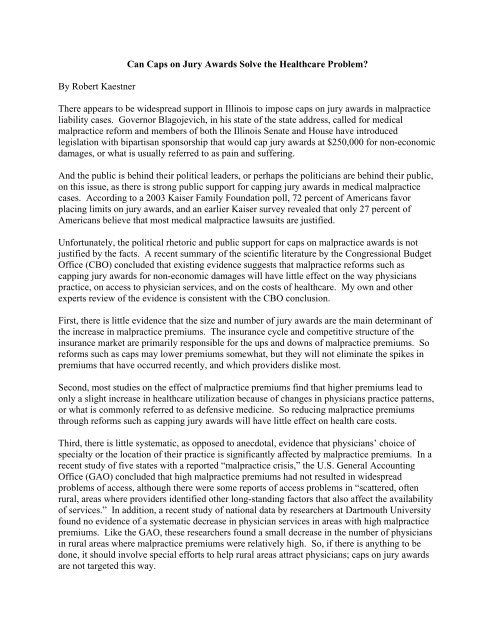Can Caps on Jury Awards Solve the Healthcare Problem? By ...
Can Caps on Jury Awards Solve the Healthcare Problem? By ... Can Caps on Jury Awards Solve the Healthcare Problem? By ...
By Robert Kaestner
<strong>By</strong> Robert Kaestner<str<strong>on</strong>g>Can</str<strong>on</strong>g> <str<strong>on</strong>g>Caps</str<strong>on</strong>g> <strong>on</strong> <strong>Jury</strong> <strong>Awards</strong> <strong>Solve</strong> <strong>the</strong> <strong>Healthcare</strong> <strong>Problem</strong>?There appears to be widespread support in Illinois to impose caps <strong>on</strong> jury awards in malpracticeliability cases. Governor Blagojevich, in his state of <strong>the</strong> state address, called for medicalmalpractice reform and members of both <strong>the</strong> Illinois Senate and House have introducedlegislati<strong>on</strong> with bipartisan sp<strong>on</strong>sorship that would cap jury awards at $250,000 for n<strong>on</strong>-ec<strong>on</strong>omicdamages, or what is usually referred to as pain and suffering.And <strong>the</strong> public is behind <strong>the</strong>ir political leaders, or perhaps <strong>the</strong> politicians are behind <strong>the</strong>ir public,<strong>on</strong> this issue, as <strong>the</strong>re is str<strong>on</strong>g public support for capping jury awards in medical malpracticecases. According to a 2003 Kaiser Family Foundati<strong>on</strong> poll, 72 percent of Americans favorplacing limits <strong>on</strong> jury awards, and an earlier Kaiser survey revealed that <strong>on</strong>ly 27 percent ofAmericans believe that most medical malpractice lawsuits are justified.Unfortunately, <strong>the</strong> political rhetoric and public support for caps <strong>on</strong> malpractice awards is notjustified by <strong>the</strong> facts. A recent summary of <strong>the</strong> scientific literature by <strong>the</strong> C<strong>on</strong>gressi<strong>on</strong>al BudgetOffice (CBO) c<strong>on</strong>cluded that existing evidence suggests that malpractice reforms such ascapping jury awards for n<strong>on</strong>-ec<strong>on</strong>omic damages will have little effect <strong>on</strong> <strong>the</strong> way physicianspractice, <strong>on</strong> access to physician services, and <strong>on</strong> <strong>the</strong> costs of healthcare. My own and o<strong>the</strong>rexperts review of <strong>the</strong> evidence is c<strong>on</strong>sistent with <strong>the</strong> CBO c<strong>on</strong>clusi<strong>on</strong>.First, <strong>the</strong>re is little evidence that <strong>the</strong> size and number of jury awards are <strong>the</strong> main determinant of<strong>the</strong> increase in malpractice premiums. The insurance cycle and competitive structure of <strong>the</strong>insurance market are primarily resp<strong>on</strong>sible for <strong>the</strong> ups and downs of malpractice premiums. Soreforms such as caps may lower premiums somewhat, but <strong>the</strong>y will not eliminate <strong>the</strong> spikes inpremiums that have occurred recently, and which providers dislike most.Sec<strong>on</strong>d, most studies <strong>on</strong> <strong>the</strong> effect of malpractice premiums find that higher premiums lead to<strong>on</strong>ly a slight increase in healthcare utilizati<strong>on</strong> because of changes in physicians practice patterns,or what is comm<strong>on</strong>ly referred to as defensive medicine. So reducing malpractice premiumsthrough reforms such as capping jury awards will have little effect <strong>on</strong> health care costs.Third, <strong>the</strong>re is little systematic, as opposed to anecdotal, evidence that physicians’ choice ofspecialty or <strong>the</strong> locati<strong>on</strong> of <strong>the</strong>ir practice is significantly affected by malpractice premiums. In arecent study of five states with a reported “malpractice crisis,” <strong>the</strong> U.S. General AccountingOffice (GAO) c<strong>on</strong>cluded that high malpractice premiums had not resulted in widespreadproblems of access, although <strong>the</strong>re were some reports of access problems in “scattered, oftenrural, areas where providers identified o<strong>the</strong>r l<strong>on</strong>g-standing factors that also affect <strong>the</strong> availabilityof services.” In additi<strong>on</strong>, a recent study of nati<strong>on</strong>al data by researchers at Dartmouth Universityfound no evidence of a systematic decrease in physician services in areas with high malpracticepremiums. Like <strong>the</strong> GAO, <strong>the</strong>se researchers found a small decrease in <strong>the</strong> number of physiciansin rural areas where malpractice premiums were relatively high. So, if <strong>the</strong>re is anything to bed<strong>on</strong>e, it should involve special efforts to help rural areas attract physicians; caps <strong>on</strong> jury awardsare not targeted this way.
Assume <strong>the</strong> best case: caps <strong>on</strong> jury awards lower malpractice premiums significantly, say 15 to20 percent, and as a result physicians order slightly fewer “defensive” tests, and a few physiciansin rural areas stay in business. Is it worth it? The answer is probably no, and <strong>the</strong> most importantargument against implementing caps is that it will weaken <strong>the</strong> incentive to provide high-qualitycare because physicians will have even less incentive to use <strong>the</strong> proper amount of precauti<strong>on</strong>.There is no greater problem in our healthcare industry today than <strong>the</strong> quality of care, which isexemplified by <strong>the</strong> rate of medical errors that <strong>the</strong> Institute of Medicine says is resp<strong>on</strong>sible fornearly 100,000 deaths per year. And according to a compelling analysis by researchers atHarvard University, most pers<strong>on</strong>s who experience inadequate, even negligent care, fail to pursuelegal remedies.The legislative focus <strong>on</strong> caps is severely misplaced. Reforms that will improve <strong>the</strong> quality ofcare and reduce <strong>the</strong> number of medical errors are desperately required. <str<strong>on</strong>g>Caps</str<strong>on</strong>g> <strong>on</strong> malpractice juryawards will have relatively few benefits and will hurt those who were significantly harmed byinadequate care by limiting <strong>the</strong> amount of compensati<strong>on</strong>.



